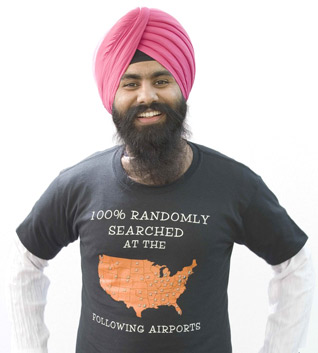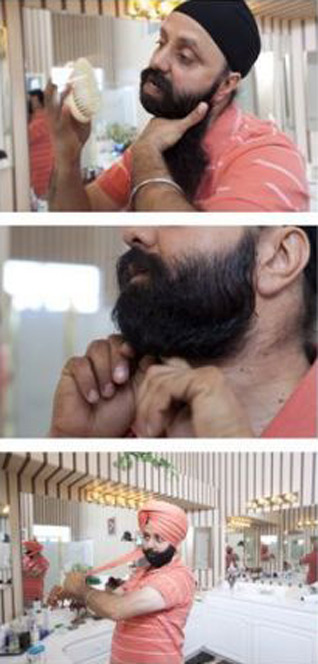Art
Photographing Sikhs With Fiona Aboud
GINA RYDER
For the past five years photographer Fiona Aboud has been traveling around the U.S. taking pictures of Sikh-Americans.
Part of her series, Sikhs: An American Portrait was recently featured in Huffington as the general public was gathering more information about Sikhs after the gurdwara shooting in Wisconsin. Inspired by the color palettes and environments of the American realist painters, Aboud captures Sikhs literally in their backyards among other everyday places.
With an estimated million Sikhs living in America, Aboud searches for the most interesting individuals to photograph such as the number one peach farmer in the U.S. and a famous Sikh actor. Her project is 80 percent finished.
The New York based Brazilian photographer has a book planned as well as a ten-city traveling outdoor pop-up exhibit. The underlying question her work seems to answer is, "How we we teach people not to hate?". She says, “My hope is that people seeing the pictures it will make them see how similar we are.”
How did you first hear about the Sikh community?
On September 15, 2001, Balbir Singh Sodhi was gunned down in Mesa, Arizona. He was the nation’s first post-9/11 victim of a hate murder; Balbir Singh’s killer mistook him for a Muslim Arab, though the gas-station owner had actually immigrated from Punjab to the US in 1989 and was Sikh. At the time, many press outlets profiled the Sikh community, but the results were mere sound bites.
I began to wonder what life must be like as a Sikh in America.
Sikhs I encounter often wonder why a Jewish-Lebanese-Brazilian white girl from America is so interested in them. Balbir Singh’s murder plays a part, but so does the trip I took to India in 1993, when a Sikh man took me on a tour of the magnificent Bangla Sahib Gurdwara in New Delhi. As he explained his faith, I was reminded of the ethics and values of my own Jewish upbringing. Like Jews and other minority groups, Sikh-Americans face a struggle between tradition and assimilation.
I want to capture
this shifting dynamic.
How do you find your subjects?
I met my first subjects by doing an outdoor portrait series during the Sikh day parade in New York City. After that, I photographed a family in New Jersey that I met during the parade (Rajnarind Kaur and her family) and through her and subsequent people I photographed I had an instant network of people that I reached out to. The Sikh-American network is so tight knit that once you know a couple people you can reach out to practically the entire community.
One of my photos depicts two brothers and one sister. Their uncle was Balbir Singh Sodhi. When the picture was taken, they wanted to show me how they could make a huge splash in the pool. They were belly flopping. People had been asking me what is underneath the turban so I asked the kids if they could please show me. It turned out pretty poetic, actually. A Sikh's uncut hair is very symbolic of the equality between men and women in the Sikh religion. Even though this principle does not always work out in practice, it is an ideal that many Sikhs believe. In the picture you can see that, since you can’t tell the difference.
Then you were in the bathroom taking pictures of a man putting on a turban step by step?
This is Rana Singh Sodhi in Phoenix Arizona (brother of the late Balbir Singh). He is the father of the kids in the pool. He’s been through so much. People were asking me how did they put their turban on. He was more than willing to oblige. The netting holding his beard is to set the hair in place. He removes it after a while and his beard is styled close to the face instead of wearing it loose.
Who is the man in the t-shirt?
That picture was taken during the Sikh day parade. He was one of the first people I photographed. He’s a computer IT specialist. He travels a lot. Sikhs at the time were being randomly selected for security. I wish people would just say "you have that thing on your head and we aren’t sure what it is" instead telling someone they are randomly selected. One time he wore the shirt through security and the guard chuckled. It’s a way of loading off steam at the reality that people have to face.
You took these photos before the tragedy in Wisconsin. Do you look at them differently now?
When the tragedy first happened, my heart sunk. A time frame is a time frame. The pictures have been out there. I wasn’t thinking that people need to see this. When I was speaking to the Sikh Coalition, I was thinking this is the perfect time for people to see them because they wouldn’t just see the suffering but see the positive things. I had this vision of how I wanted these pictures to look. I’m not creating a false environment; I want to portray the positive images not in crisis and in mourning. Those types of pictures are important.
But I want people to understand the vibrancy of this community.
[Courtesy: The Huffington Post. Edited for sikhchic.com]
August 14, 2012




